Integrating GIS, Remote Sensing, and Machine Learning to Optimize Sustainable Groundwater Recharge in Arid Mediterranean Landscapes: A Case Study from the Middle Draa Valley, Morocco
Abstract
1. Introduction
2. Materials and Methods
2.1. Study Area Characteristics
2.2. Methodological Framework
2.2.1. Data Acquisition and Preparation of Thematic Layers
2.2.2. Data Homogenization
2.2.3. Training Dataset
2.2.4. Multicollinearity Test
2.2.5. Prediction Mapping and Interpolation
2.2.6. Sensitivity Analysis Using SHAP
2.2.7. Algorithms Evaluation and Performance Metrics
3. Results
3.1. Conditioning Factors
3.1.1. Topographical Factors
Elevation
Slope
Curvature
3.1.2. Hydrogeological Factors
Distance from Main Streams
Topographic Wetness Index (TWI)
Rainfall
3.1.3. Geological Factors
Soil Permeability
- Group A: High permeability (rating = 4), comprising sandy, loamy sand, and sandy loam soils.
- Group B: Moderate permeability (rating = 3), consisting of loam and silt loam.
- Group C: Low permeability (rating = 2), represented by sandy clay loam.
- Group D: Very low permeability (rating = 1), corresponding to bare rocky outcrops in mountainous zones.
Geomorphology
Lineament Density
3.1.4. Anthropogenic Factor
3.2. Variable Relationships and Multicollinearity
3.3. Groundwater Suitability Predictions Using ML Algorithms
3.4. SHAP-Based Sensitivity Analysis
3.5. Real-World Implications: Where Is Groundwater Recharge Most Likely to Occur?
3.6. Evaluating Algorithms Performance
4. Discussion
5. Conclusions
Author Contributions
Funding
Data Availability Statement
Acknowledgments
Conflicts of Interest
References
- Arafa, N.A.; El-Said Salem, Z.; Abdeldayem, A.L.; Ghorab, M.A.; Moustafa, Y.M.; Soliman, S.A.; Farag, M.H.; Purohit, S.; Elhag, M.; Youssef, Y.M. Advancing Deltaic Aquifer Vulnerability Mapping to Seawater Intrusion and Human Impacts in Eastern Nile Delta: Insights from Machine Learning and Hydrochemical Perspective. Earth Syst. Environ. 2024, 1–26. [Google Scholar] [CrossRef]
- El-Said Salem, Z.; Arafa, N.A.; Abdeldayem, A.L.; Youssef, Y.M. Machine Learning-Enhanced GALDIT Modeling for the Nile Delta Aquifer Vulnerability Assessment in the Mediterranean Region. Groundw. Sustain. Dev. 2025, 28, 101403. [Google Scholar] [CrossRef]
- Khouz, A.; Trindade, J.; El Bchari, F.; Santos, P.P.; Reis, E.; Moumane, A.; Ezzahra El Ghazali, F.; Jadoud, M.; Bougadir, B. Integrating GALDIT and GIS for Assessing Sea Water Intrusion Susceptibility in the Akermoud Coastal Water Table, Morocco: Implications for Sustainability. In Advances in Geospatial Technologies; Batchi, M., Moumane, A., Eds.; IGI Global: Hershey, PA, USA, 2024; pp. 35–72. ISBN 979-8-3693-9651-3. [Google Scholar]
- Henao Casas, J.D.; Fernández Escalante, E.; Ayuga, F. Alleviating Drought and Water Scarcity in the Mediterranean Region through Managed Aquifer Recharge. Hydrogeol. J. 2022, 30, 1685–1699. [Google Scholar] [CrossRef]
- Youssef, Y.M.; Gemail, K.S.; Sugita, M.; AlBarqawy, M.; Teama, M.A.; Koch, M.; Saada, S.A. Natural and Anthropogenic Coastal Environmental Hazards: An Integrated Remote Sensing, GIS, and Geophysical-Based Approach. Surv. Geophys. 2021, 42, 1109–1141. [Google Scholar] [CrossRef]
- Bouchaou, L.; El Alfy, M.; Shanafield, M.; Siffeddine, A.; Sharp, J. Groundwater in Arid and Semi-Arid Areas. Geosciences 2024, 14, 332. [Google Scholar] [CrossRef]
- Bahouq, T.; Moumane, A.; Touhami, N. Monitoring Agricultural Dynamics and Its Impact on Water Resources Using GIS and Remote Sensing Data: A Case Study in the Ben Mansour-Mnasra Region, Kenitra, Morocco. In Advances in Geospatial Technologies; Batchi, M., Moumane, A., Eds.; IGI Global: Hershey, PA, USA, 2024; pp. 183–210. ISBN 979-8-3693-9651-3. [Google Scholar]
- Moumane, A.; Bahouq, T.; Ghazi, A. Integrating GIS, Remote Sensing, and Analytic Hierarchical Process (AHP) for Mapping of Groundwater-Recharge Potential Zones in Kenitra Province, Morocco: Toward Sustainable Development Goals Achievement. Euro-Mediterr. J. Environ. Integr. 2025, 10, 831–851. [Google Scholar] [CrossRef]
- Embaby, A.; Youssef, Y.M.; Abu El-Magd, S.A. Delineation of Lineaments for Groundwater Prospecting in Hard Rocks: Inferences from Remote Sensing and Geophysical Data. Environ. Earth Sci. 2024, 83, 62. [Google Scholar] [CrossRef]
- Ahmed, M.; Aqnouy, M.; Stitou El Messari, J. Sustainability of Morocco’s Groundwater Resources in Response to Natural and Anthropogenic Forces. J. Hydrol. 2021, 603, 126866. [Google Scholar] [CrossRef]
- Alcalá, F.J.; Martínez-Valderrama, J.; Robles-Marín, P.; Guerrera, F.; Martín-Martín, M.; Raffaelli, G.; De León, J.T.; Asebriy, L. A Hydrological–Economic Model for Sustainable Groundwater Use in Sparse-Data Drylands: Application to the Amtoudi Oasis in Southern Morocco, Northern Sahara. Sci. Total Environ. 2015, 537, 309–322. [Google Scholar] [CrossRef]
- Echogdali, F.Z.; Boutaleb, S.; Bendarma, A.; Saidi, M.E.; Aadraoui, M.; Abioui, M.; Ouchchen, M.; Abdelrahman, K.; Fnais, M.S.; Sajinkumar, K.S. Application of Analytical Hierarchy Process and Geophysical Method for Groundwater Potential Mapping in the Tata Basin, Morocco. Water 2022, 14, 2393. [Google Scholar] [CrossRef]
- Boudellah, A.; Moustaine, R.E.; Gharmali, A.E.; Maliki, A.; Moutaouakil, S.; Bouriqi, A.; Khouz, A.; Boulanouar, M.; Ibouh, H.; Ghamizi, M.; et al. Groundwater Quality in Zagora Southeast of Morocco by Using Physicochemical Analysis and Geospatial Techniques. Environ. Monit. Assess. 2023, 195, 624. [Google Scholar] [CrossRef]
- Karmaoui, A.; Minucci, G.; Messouli, M.; Khebiza, M.Y.; Ifaadassan, I.; Babqiqi, A. Climate Change Impacts on Water Supply System of the Middle Draa Valley in South Morocco. In Climate Change, Food Security and Natural Resource Management; Behnassi, M., Pollmann, O., Gupta, H., Eds.; Springer International Publishing: Cham, Switzerland, 2019; pp. 163–178. ISBN 978-3-319-97090-5. [Google Scholar]
- Warner, N.; Lgourna, Z.; Bouchaou, L.; Boutaleb, S.; Tagma, T.; Hsaissoune, M.; Vengosh, A. Integration of Geochemical and Isotopic Tracers for Elucidating Water Sources and Salinization of Shallow Aquifers in the Sub-Saharan Drâa Basin, Morocco. Appl. Geochem. 2013, 34, 140–151. [Google Scholar] [CrossRef]
- Moumane, A.; Al Karkouri, J.; Benmansour, A.; El Ghazali, F.E.; Fico, J.; Karmaoui, A.; Batchi, M. Monitoring Long-Term Land Use, Land Cover Change, and Desertification in the Ternata Oasis, Middle Draa Valley, Morocco. Remote Sens. Appl. Soc. Environ. 2022, 26, 100745. [Google Scholar] [CrossRef]
- Rössler, M.; Kirscht, H.; Rademacher, C.; Platt, S.; Kemmerling, B.; Linstädter, A. II-5.4 Migration and Resource Management in the Drâa Valley, Southern Morocco. In Impacts of Global Change on the Hydrological Cycle in West and Northwest Africa; Springer: Berlin/Heidelberg, Germany, 2010. [Google Scholar]
- Karmaoui, A.; Moumane, A. Changes in the Environmental Vulnerability of Oasean System (Desert Oasis), Pilot Study in Middle Draa Valley, Morocco. Expert Opin. Environ. Biol. 2016, 5. [Google Scholar] [CrossRef]
- Johannsen, I.; Hengst, J.; Goll, A.; Höllermann, B.; Diekkrüger, B. Future of Water Supply and Demand in the Middle Drâa Valley, Morocco, under Climate and Land Use Change. Water 2016, 8, 313. [Google Scholar] [CrossRef]
- Akdim, M.; Akdim, H.; Sabiri, A.; Alami, A. Land-Use Change and Sustainability in the South-Eastern Oases of Morocco. BGSS 2023, 59, 95–109. [Google Scholar] [CrossRef]
- Moumane, A.; El Ghazali, F.E.; Al Karkouri, J.; Delorme, J.; Batchi, M.; Chafiki, D.; Karmaoui, A. Monitoring Spatiotemporal Variation of Groundwater Level and Salinity under Land Use Change Using Integrated Field Measurements, GIS, Geostatistical, and Remote-Sensing Approach: Case Study of the Feija Aquifer, Middle Draa Watershed, Moroccan Sahara. Environ. Monit. Assess. 2021, 193, 769. [Google Scholar] [CrossRef]
- Sfa, F.E.; Nemiche, M.; Rayd, H. A Generic Macroscopic Cellular Automata Model for Land Use Change: The Case of the Drâa Valley. Ecol. Complex. 2020, 43, 100851. [Google Scholar] [CrossRef]
- Lamqadem, A.A.; Saber, H.; Pradhan, B. Long-Term Monitoring of Transformation from Pastoral to Agricultural Land Use Using Time-Series Landsat Data in the Feija Basin (Southeast Morocco). Earth Syst. Environ. 2019, 3, 525–538. [Google Scholar] [CrossRef]
- Silva-Novoa Sánchez, L.M.; Bossenbroek, L.; Schilling, J.; Berger, E. Governance and Sustainability Challenges in the Water Policy of Morocco 1995–2020: Insights from the Middle Draa Valley. Water 2022, 14, 2932. [Google Scholar] [CrossRef]
- Silva-Novoa Sánchez, L.M.; Schilling, J.; Bossenbroek, L.; Ezzayyat, R.; Berger, E. Drivers of Conflict over Customary Land in the Middle Drâa Valley of Morocco. World Dev. 2025, 188, 106872. [Google Scholar] [CrossRef]
- Karmaoui, A.; Moumane, A.; Akchbab, J. Environmental Hazards Assessment at Pre-Saharan Local Scale: Case Study from the Draa Valley, Morocco. In Advances in Environmental Engineering and Green Technologies; Karmaoui, A., Ed.; IGI Global: Hershey, PA, USA, 2020; pp. 250–267. ISBN 978-1-5225-9771-1. [Google Scholar]
- Fico, J. Frontiers of Fortune: Mobilising Land, Water, and Collective Identity for Watermelon Production in Southeastern Morocco. J. N. Afr. Stud. 2024, 1–24. [Google Scholar] [CrossRef]
- Echogdali, F.Z.; Boutaleb, S.; Jauregui, J.; Elmouden, A. Cartography of Flooding Hazard in Semi-Arid Climate: The Case of Tata Valley (South-East of Morocco). J. Geogr. Nat. Disast. 2018, 8, 1000214. [Google Scholar] [CrossRef]
- Moumane, A.; Bahouq, T.; Karmaoui, A.; Laghfiri, D.; Yassine, M.; Karkouri, J.A.; Batchi, M.; Faouzi, M.; Boulakhbar, M.; Youssef, A.A. Lake Iriqui’s Remarkable Revival: Field Observations and a Google Earth Engine Analysis of Its Recovery After over Half a Century of Desiccation. Land 2025, 14, 104. [Google Scholar] [CrossRef]
- Al-Ruzouq, R.; Shanableh, A.; Mukherjee, S.; Khalil, M.A.; Gibril, M.B.; Jena, R.; Yilmaz, A.G.; Hammouri, N.A. Comparative Analysis of Machine Learning and Analytical Hierarchy Analysis for Artificial Groundwater Recharge Map Development. Environ. Earth Sci. 2023, 82, 580. [Google Scholar] [CrossRef]
- Arabameri, A.; Pal, S.C.; Rezaie, F.; Nalivan, O.A.; Chowdhuri, I.; Saha, A.; Lee, S.; Moayedi, H. Modeling Groundwater Potential Using Novel GIS-Based Machine-Learning Ensemble Techniques. J. Hydrol. Reg. Stud. 2021, 36, 100848. [Google Scholar] [CrossRef]
- Bai, Z.; Liu, Q.; Liu, Y. Groundwater Potential Mapping in Hubei Region of China Using Machine Learning, Ensemble Learning, Deep Learning and AutoML Methods. Nat. Resour. Res. 2022, 31, 2549–2569. [Google Scholar] [CrossRef]
- Fatah, K.K.; Mustafa, Y.T.; Hassan, I.O. Groundwater Potential Mapping in Arid and Semi-Arid Regions of Kurdistan Region of Iraq: A Geoinformatics-Based Machine Learning Approach. Groundw. Sustain. Dev. 2024, 27, 101337. [Google Scholar] [CrossRef]
- Jari, A.; Bachaoui, E.M.; Hajaj, S.; Khaddari, A.; Khandouch, Y.; El Harti, A.; Jellouli, A.; Namous, M. Investigating Machine Learning and Ensemble Learning Models in Groundwater Potential Mapping in Arid Region: Case Study from Tan-Tan Water-Scarce Region, Morocco. Front. Water 2023, 5, 1305998. [Google Scholar] [CrossRef]
- Kanji, S.; Das, S. Assessing Groundwater Potentialities and Replenishment Feasibility Using Machine Learning and MCDM Models Considering Hydro-Geological Aspects and Water Quality Constituents. Environ. Earth Sci. 2025, 84, 16. [Google Scholar] [CrossRef]
- Nugroho, J.T.; Lestari, A.I.; Gustiandi, B.; Sofan, P.; Suwarsono; Prasasti, I.; Rahmi, K.I.N.; Noviar, H.; Sari, N.M.; Manalu, R.J.; et al. Groundwater Potential Mapping Using Machine Learning Approach in West Java, Indonesia. Groundw. Sustain. Dev. 2024, 27, 101382. [Google Scholar] [CrossRef]
- Ragragui, H.; Aouragh, M.H.; El-Hmaidi, A.; Ouali, L.; Saouita, J.; Iallamen, Z.; Ousmana, H.; Jaddi, H.; El Ouali, A. Mapping and Modeling Groundwater Potential Using Machine Learning, Deep Learning and Ensemble Learning Models in the Saiss Basin (Fez-Meknes Region, Morocco). Groundw. Sustain. Dev. 2024, 26, 101281. [Google Scholar] [CrossRef]
- Roy, S.K.; Hasan, M.d.M.; Mondal, I.; Akhter, J.; Roy, S.K.; Talukder, S.; Islam, A.K.M.S.; Rahman, A.; Karuppannan, S. Empowered Machine Learning Algorithm to Identify Sustainable Groundwater Potential Zone Map in Jashore District, Bangladesh. Groundw. Sustain. Dev. 2024, 25, 101168. [Google Scholar] [CrossRef]
- Naghibi, S.A.; Pourghasemi, H.R.; Dixon, B. GIS-Based Groundwater Potential Mapping Using Boosted Regression Tree, Classification and Regression Tree, and Random Forest Machine Learning Models in Iran. Environ. Monit. Assess. 2016, 188, 44. [Google Scholar] [CrossRef] [PubMed]
- Mosavi, A.; Sajedi Hosseini, F.; Choubin, B.; Goodarzi, M.; Dineva, A.A.; Rafiei Sardooi, E. Ensemble Boosting and Bagging Based Machine Learning Models for Groundwater Potential Prediction. Water Resour. Manag. 2021, 35, 23–37. [Google Scholar] [CrossRef]
- Naghibi, S.A.; Ahmadi, K.; Daneshi, A. Application of Support Vector Machine, Random Forest, and Genetic Algorithm Optimized Random Forest Models in Groundwater Potential Mapping. Water Resour. Manag. 2017, 31, 2761–2775. [Google Scholar] [CrossRef]
- Guo, X.; Gui, X.; Xiong, H.; Hu, X.; Li, Y.; Cui, H.; Qiu, Y.; Ma, C. Critical Role of Climate Factors for Groundwater Potential Mapping in Arid Regions: Insights from Random Forest, XGBoost, and LightGBM Algorithms. J. Hydrol. 2023, 621, 129599. [Google Scholar] [CrossRef]
- Huang, Z.; Nya, E.L.; Rahman, M.A.; Mwamila, T.B.; Cao, V.; Gwenzi, W.; Noubactep, C. Integrated Water Resource Management: Rethinking the Contribution of Rainwater Harvesting. Sustainability 2021, 13, 8338. [Google Scholar] [CrossRef]
- Xiong, H.; Guo, X.; Wang, Y.; Xiong, R.; Gui, X.; Hu, X.; Li, Y.; Qiu, Y.; Tan, J.; Ma, C. Spatial Prediction of Groundwater Potential by Various Novel Boosting-Based Ensemble Learning Models in Mountainous Areas. Geocarto Int. 2023, 38, 2274870. [Google Scholar] [CrossRef]
- Liu, B.; Sun, Y.; Gao, L. Enhancing Groundwater Recharge Prediction: A Feature Selection-Based Deep Forest Model With Bayesian Optimisation. Hydrol. Process. 2024, 38, e15309. [Google Scholar] [CrossRef]
- Kamali Maskooni, E.; Naghibi, S.A.; Hashemi, H.; Berndtsson, R. Application of Advanced Machine Learning Algorithms to Assess Groundwater Potential Using Remote Sensing-Derived Data. Remote Sens. 2020, 12, 2742. [Google Scholar] [CrossRef]
- Lee, S.; Hong, S.-M.; Jung, H.-S. GIS-Based Groundwater Potential Mapping Using Artificial Neural Network and Support Vector Machine Models: The Case of Boryeong City in Korea. Geocarto Int. 2018, 33, 847–861. [Google Scholar] [CrossRef]
- Pourghasemi, H.R.; Sadhasivam, N.; Yousefi, S.; Tavangar, S.; Ghaffari Nazarlou, H.; Santosh, M. Using Machine Learning Algorithms to Map the Groundwater Recharge Potential Zones. J. Environ. Manag. 2020, 265, 110525. [Google Scholar] [CrossRef] [PubMed]
- Abdelmajid, S.; Mukhtar, A.; Baig, M.B.; Reed, M.R. Climate Change, Agricultural Policy and Food Security in Morocco. In Emerging Challenges to Food Production and Security in Asia, Middle East, and Africa; Behnassi, M., Barjees Baig, M., El Haiba, M., Reed, M.R., Eds.; Springer International Publishing: Cham, Switzerland, 2021; pp. 171–196. ISBN 978-3-030-72986-8. [Google Scholar]
- Abousserhane, Z.; Abbou, A.; Bouzakri, H. Experimental Performance Study of an Isolated PV Water Pumping System Used for Agricultural Irrigation in Zagora-Morocco Semi-Arid Area. In Digital Technologies and Applications; Motahhir, S., Bossoufi, B., Eds.; Lecture Notes in Networks and Systems; Springer Nature: Cham, Switzerland, 2023; Volume 669, pp. 660–671. ISBN 978-3-031-29859-2. [Google Scholar]
- Fico, J.; Kenti, A. Living on Luck the Story Behind Zagora’s Watermelons; Heinrich Böll Stiftung: Rabat, Maroc, 2023. [Google Scholar]
- Kaczmarek, N.; Mahjoubi, I.; Naimi, M.; Bossenbroek, L.; Moumane, A.; Znari, M.; Silva-Novoa Sánchez, L.M.; Frör, O.; Berger, E. Nature Conservation in the Draa Basin (Morocco): History, Present Situation, and Future Challenges. J. Nat. Conserv. 2025, 127038. [Google Scholar] [CrossRef]
- ABHDON. Etude D’élaboration du Contrat de Nappe de Feija. Mission 2.2 Identification des Usages et des Usagers des Ressources En Eau; Agence du bassin hydraulique de Draa Oued Noun: Guelmim, Morocco, 2021. [Google Scholar]
- ABHSMD, (Agence du Bassine Hydraulique de Souss Massa et de Draa). Etude Hydrologique de La Nappe de La Feija; Agence du Bassine Hydraulique de Souss Massa et de Draa: Agadir, Morocco, 2014. [Google Scholar]
- Klose, S. Regional Hydrogeology and Groundwater Budget Modeling in the Arid Middle Drâa Catchment (South-Morocco). Ph.D. Thesis, Universitäts- und Landesbibliothek Bonn, Bonn, Germany, 2013. [Google Scholar]
- Aboubakr, E.-Z.; Abdelhalim, T.; Ahmed, A.; Abdellah, A.; Abdelouhed, F.; Mariam, G.; Kamal, E. Hydrogeological Synthesis of Groundwater Resources: Case of the Feija Watershed (South-East of Morocco). Jeas 2021, 2, 85–94. [Google Scholar] [CrossRef]
- Gómez-Escalonilla, V.; Martínez-Santos, P.; Martín-Loeches, M. Preprocessing Approaches in Machine-Learning-Based Groundwater Potential Mapping: An Application to the Koulikoro and Bamako Regions, Mali. Hydrol. Earth Syst. Sci. 2022, 26, 221–243. [Google Scholar] [CrossRef]
- Moumane, A.; Enajar, A.A.; Ghazali, F.E.E.; Khouz, A.; Karmaoui, A.; Al Karkouri, J.; Batchi, M. GIS, Remote Sensing, and Analytical Hierarchy Process (AHP) Approach for Rainwater Harvesting Site Selection in Arid Regions: Feija Plain Case Study, Zagora (Morocco). Appl. Geomat. 2024, 16, 861–880. [Google Scholar] [CrossRef]
- Elmotawakkil, A.; Enneya, N. Advanced Machine Learning for Predicting Groundwater Decline and Drought in the Rabat–Salé–Kénitra Region, Morocco. J. Hydroinform. 2024, 26, 2980–3007. [Google Scholar] [CrossRef]
- Berk, R.A. Classification and Regression Trees (CART). In Statistical Learning from a Regression Perspective; Springer Series in Statistics; Springer New York: New York, NY, USA, 2008; pp. 1–65. ISBN 978-0-387-77500-5. [Google Scholar]
- Prinzie, A.; Van Den Poel, D. Random Forests for Multiclass Classification: Random MultiNomial Logit. Expert Syst. Appl. 2008, 34, 1721–1732. [Google Scholar] [CrossRef]
- Ke, G.; Meng, Q.; Finley, T.; Wang, T.; Chen, W.; Ma, W.; Ye, Q.; Liu, T.-Y. Lightgbm: A Highly Efficient Gradient Boosting Decision Tree. Adv. Neural Inf. Process. Syst. 2017, 30. [Google Scholar]
- Khan, A.A.; Chaudhari, O.; Chandra, R. A Review of Ensemble Learning and Data Augmentation Models for Class Imbalanced Problems: Combination, Implementation and Evaluation. Expert Syst. Appl. 2024, 244, 122778. [Google Scholar] [CrossRef]
- Cover, T.; Hart, P. Nearest Neighbor Pattern Classification. IEEE Trans. Inform. Theory 1967, 13, 21–27. [Google Scholar] [CrossRef]
- Cortes, C.; Vapnik, V. Support-Vector Networks. Mach. Learn. 1995, 20, 273–297. [Google Scholar] [CrossRef]
- SHAP Documentation Welcome to the SHAP Documentation—SHAP Latest Documentation. Available online: https://shap.readthedocs.io/en/latest/ (accessed on 14 July 2025).
- Armanuos, A.M.; Elshaarawy, M.K. Estimating Saltwater Wedge Length in Sloping Coastal Aquifers Using Explainable Machine Learning Models. Earth Sci. Inf. 2025, 18, 405. [Google Scholar] [CrossRef]
- Dahal, K.; Sharma, S.; Shakya, A.; Talchabhadel, R.; Adhikari, S.; Pokharel, A.; Sheng, Z.; Pradhan, A.M.S.; Kumar, S. Identification of Groundwater Potential Zones in Data-Scarce Mountainous Region Using Explainable Machine Learning. J. Hydrol. 2023, 627, 130417. [Google Scholar] [CrossRef]
- Shelar, R.S.; Nandgude, S.B.; Pande, C.B.; Costache, R.; El-Hiti, G.A.; Tolche, A.D.; Son, C.T.; Yadav, K.K. Unlocking the Hidden Potential: Groundwater Zone Mapping Using AHP, Remote Sensing and GIS Techniques. Geomat. Nat. Hazards Risk 2023, 14, 2264458. [Google Scholar] [CrossRef]
- Lindle, J.; Villholth, K.G.; Ebrahim, G.Y.; Sorensen, J.P.R.; Taylor, R.G.; Jensen, K.H. Groundwater Recharge Influenced by Ephemeral River Flow and Land Use in the Semiarid Limpopo Province of South Africa. Hydrogeol. J. 2023, 31, 2291–2306. [Google Scholar] [CrossRef]
- Raja Shekar, P.; Mathew, A. Assessing Groundwater Potential Zones and Artificial Recharge Sites in the Monsoon-Fed Murredu River Basin, India: An Integrated Approach Using GIS, AHP, and Fuzzy-AHP. Groundw. Sustain. Dev. 2023, 23, 100994. [Google Scholar] [CrossRef]
- Karmakar, M.; Ghosh, D. A GIS-Based Approach for Identification of Optimum Runoff Harvesting Sites and Storage Estimation: A Study from Subarnarekha-Kangsabati Interfluve, India. Appl. Geomat. 2022, 14, 253–266. [Google Scholar] [CrossRef]
- Alikhanov, B.; Juliev, M.; Alikhanova, S.; Mondal, I. Assessment of Influencing Factor Method for Delineation of Groundwater Potential Zones with Geospatial Techniques. Case Study of Bostanlik District, Uzbekistan. Groundw. Sustain. Dev. 2021, 12, 100548. [Google Scholar] [CrossRef]
- Selvam, S.; Dar, F.A.; Magesh, N.S.; Singaraja, C.; Venkatramanan, S.; Chung, S.Y. Application of Remote Sensing and GIS for Delineating Groundwater Recharge Potential Zones of Kovilpatti Municipality, Tamil Nadu Using IF Technique. Earth Sci. Inform. 2016, 9, 137–150. [Google Scholar] [CrossRef]
- Maqsoom, A.; Aslam, B.; Khalid, N.; Ullah, F.; Anysz, H.; Almaliki, A.H.; Almaliki, A.A.; Hussein, E.E. Delineating Groundwater Recharge Potential through Remote Sensing and Geographical Information Systems. Water 2022, 14, 1824. [Google Scholar] [CrossRef]
- Danso, S.Y.; Ma, Y. Geospatial Techniques for Groundwater Potential Zones Delineation in a Coastal Municipality, Ghana. Egypt. J. Remote Sens. Space Sci. 2023, 26, 75–84. [Google Scholar] [CrossRef]
- Jaafarzadeh, M.S.; Tahmasebipour, N.; Haghizadeh, A.; Pourghasemi, H.R.; Rouhani, H. Groundwater Recharge Potential Zonation Using an Ensemble of Machine Learning and Bivariate Statistical Models. Sci. Rep. 2021, 11, 5587. [Google Scholar] [CrossRef] [PubMed]
- Donselaar, M.E.; Bhatt, A.G.; Ghosh, A.K. On the Relation between Fluvio-Deltaic Flood Basin Geomorphology and the Wide-Spread Occurrence of Arsenic Pollution in Shallow Aquifers. Sci. Total Environ. 2017, 574, 901–913. [Google Scholar] [CrossRef]
- Letz, O.; Siebner, H.; Avrahamov, N.; Egozi, R.; Eshel, G.; Dahan, O. The Impact of Geomorphology on Groundwater Recharge in a Semi-Arid Mountainous Area. J. Hydrol. 2021, 603, 127029. [Google Scholar] [CrossRef]
- Blackburn, J.; Comte, J.-C.; Foster, G.; Gibbins, C. Hydrogeological Controls on the Flow Regime of an Ephemeral Temperate Stream Flowing across an Alluvial Fan. J. Hydrol. 2021, 595, 125994. [Google Scholar] [CrossRef]
- Achu, A.L.; Thomas, J.; Reghunath, R. Multi-Criteria Decision Analysis for Delineation of Groundwater Potential Zones in a Tropical River Basin Using Remote Sensing, GIS and Analytical Hierarchy Process (AHP). Groundw. Sustain. Dev. 2020, 10, 100365. [Google Scholar] [CrossRef]
- Ghosh, A.; Adhikary, P.P.; Bera, B.; Bhunia, G.S.; Shit, P.K. Assessment of Groundwater Potential Zone Using MCDA and AHP Techniques: Case Study from a Tropical River Basin of India. Appl. Water Sci. 2022, 12, 37. [Google Scholar] [CrossRef]
- Mishra, A.K.; Upadhyay, A.; Srivastava, A.; Rai, S.C. Probabilistic Groundwater Recharge Zonation in Hard Rock Terrain Using Geospatial Techniques in Veniar Watershed, South India. Ecohydrol. Hydrobiol. 2020, 20, 456–471. [Google Scholar] [CrossRef]
- Baghel, S.; Tripathi, M.P.; Khalkho, D.; Al-Ansari, N.; Kumar, A.; Elbeltagi, A. Delineation of Suitable Sites for Groundwater Recharge Based on Groundwater Potential with RS, GIS, and AHP Approach for Mand Catchment of Mahanadi Basin. Sci. Rep. 2023, 13, 9860. [Google Scholar] [CrossRef]
- Jena, S.; Panda, R.K.; Ramadas, M.; Mohanty, B.P.; Pattanaik, S.K. Delineation of Groundwater Storage and Recharge Potential Zones Using RS-GIS-AHP: Application in Arable Land Expansion. Remote Sens. Appl. Soc. Environ. 2020, 19, 100354. [Google Scholar] [CrossRef]
- Hosseini, F.S.; Jafari, A.; Zandi, I.; Alesheikh, A.A.; Rezaie, F. Groundwater Potential Mapping Using Optimized Decision Tree-Based Ensemble Learning Model with Local and Global Explainability. Water 2025, 17, 1520. [Google Scholar] [CrossRef]
- Anand, V.; Rajput, V.D.; Minkina, T.; Mandzhieva, S.; Sharma, A.; Kumar, D.; Kumar, S. Evaluating Groundwater Potential with the Synergistic Use of Geospatial Methods and Advanced Machine Learning Approaches. Discov. Cities 2025, 2, 56. [Google Scholar] [CrossRef]
- Prasad, P.; Loveson, V.J.; Kotha, M.; Yadav, R. Application of Machine Learning Techniques in Groundwater Potential Mapping along the West Coast of India. GIScience Remote Sens. 2020, 57, 735–752. [Google Scholar] [CrossRef]
- Amiha, R.; Kabbachi, B.; Ait Haddou, M.; Hamma, K.; Bouchriti, Y.; Gougueni, H. Climate Vulnerability and Adaptation Strategies in the Zagora Oasis, Southern Morocco: A Time Series Analysis and Projection to 2050. Theor. Appl. Climatol. 2024, 155, 9767–9781. [Google Scholar] [CrossRef]
- Halder, K.; Srivastava, A.K.; Ghosh, A.; Nabik, R.; Pan, S.; Chatterjee, U.; Bisai, D.; Pal, S.C.; Zeng, W.; Ewert, F.; et al. Application of Bagging and Boosting Ensemble Machine Learning Techniques for Groundwater Potential Mapping in a Drought-Prone Agriculture Region of Eastern India. Environ Sci. Eur. 2024, 36, 155. [Google Scholar] [CrossRef]
- Morgan, H.; Madani, A.; Hussien, H.M.; Nassar, T. Using an Ensemble Machine Learning Model to Delineate Groundwater Potential Zones in Desert Fringes of East Esna-Idfu Area, Nile Valley, Upper Egypt. Geosci. Lett. 2023, 10, 9. [Google Scholar] [CrossRef]
- Elhassouny, A. Machine Learning Models for Predicting Spatiotemporal Dynamics of Groundwater Recharge. Renew. Energy Sustain. Dev. 2024, 10, 319–344. [Google Scholar] [CrossRef]
- Halder, S.; Banerjee, S.; Youssef, Y.M.; Chandel, A.; Alarifi, N.; Bhandari, G.; Abd-Elmaboud, M.E. Ground–Surface Water Assessment for Agricultural Land Prioritization in the Upper Kansai Basin, India: An Integrated SWAT-VIKOR Framework Approach. Water 2025, 17, 880. [Google Scholar] [CrossRef]
- Rehman, A.; Xue, L.; Islam, F.; Ahmed, N.; Qaysi, S.; Liu, S.; Alarifi, N.; Youssef, Y.M.; Abd-Elmaboud, M.E. Unveiling Groundwater Potential in Hangu District, Pakistan: A GIS-Driven Bivariate Modeling and Remote Sensing Approach for Achieving SDGs. Water 2024, 16, 3317. [Google Scholar] [CrossRef]
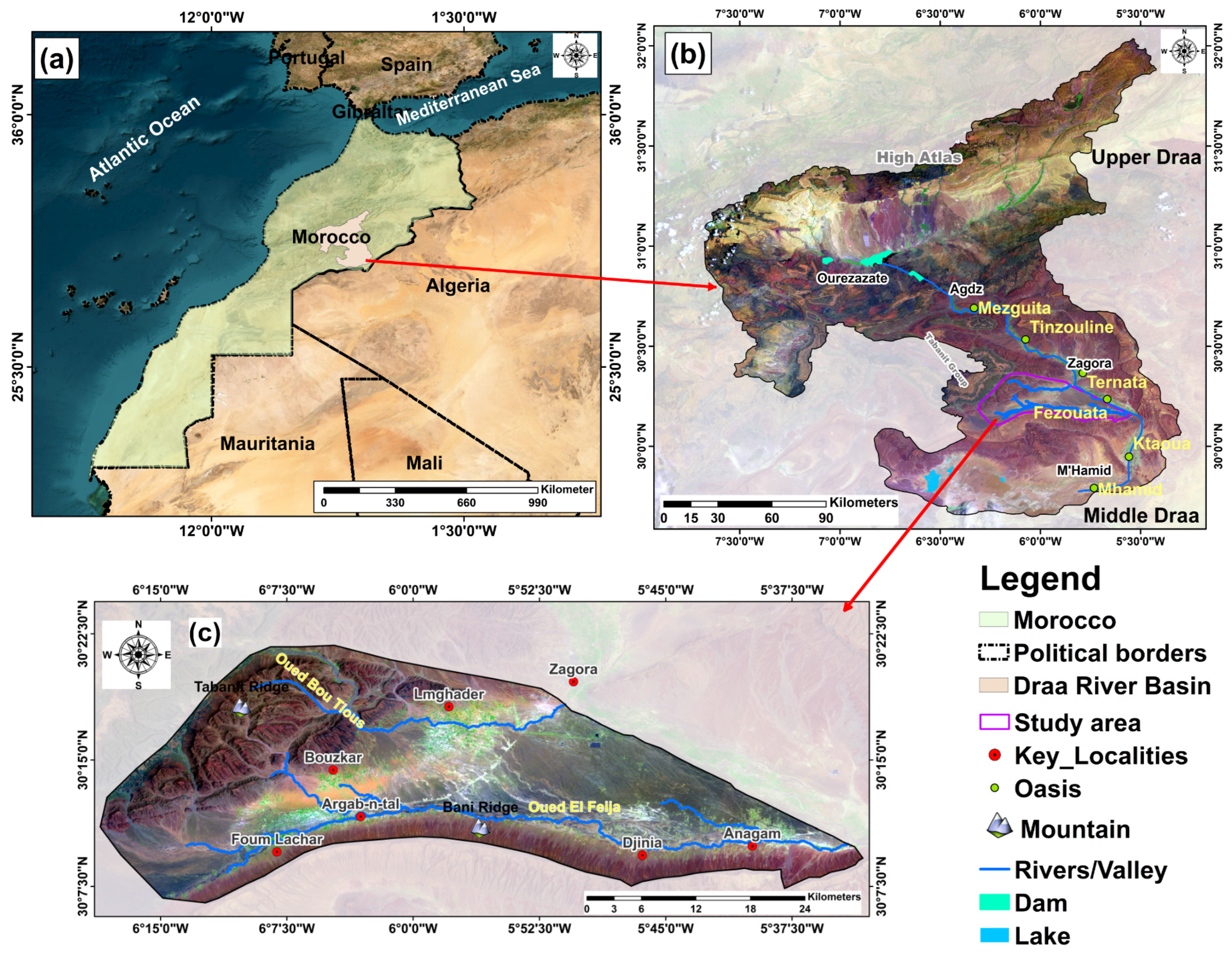

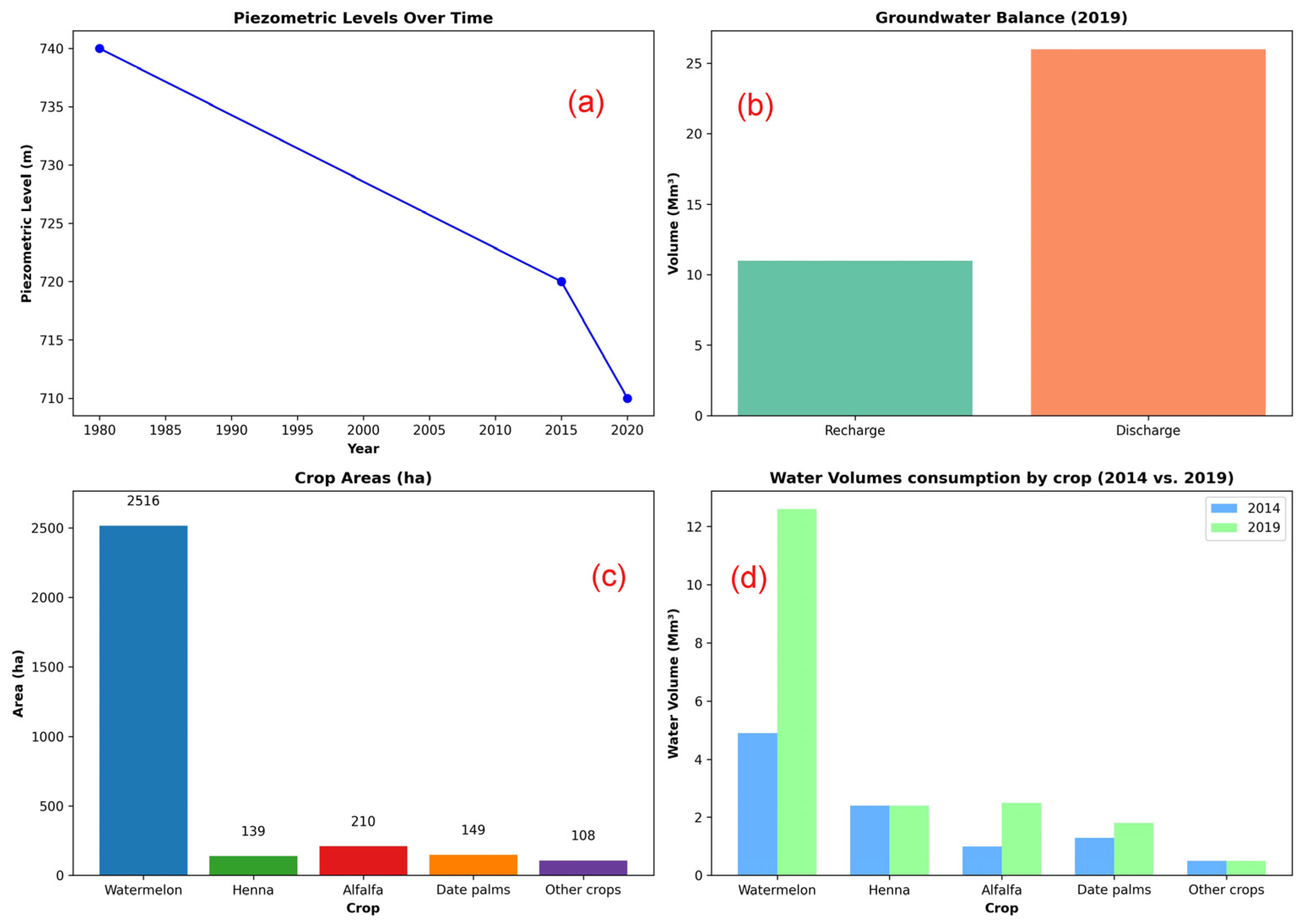
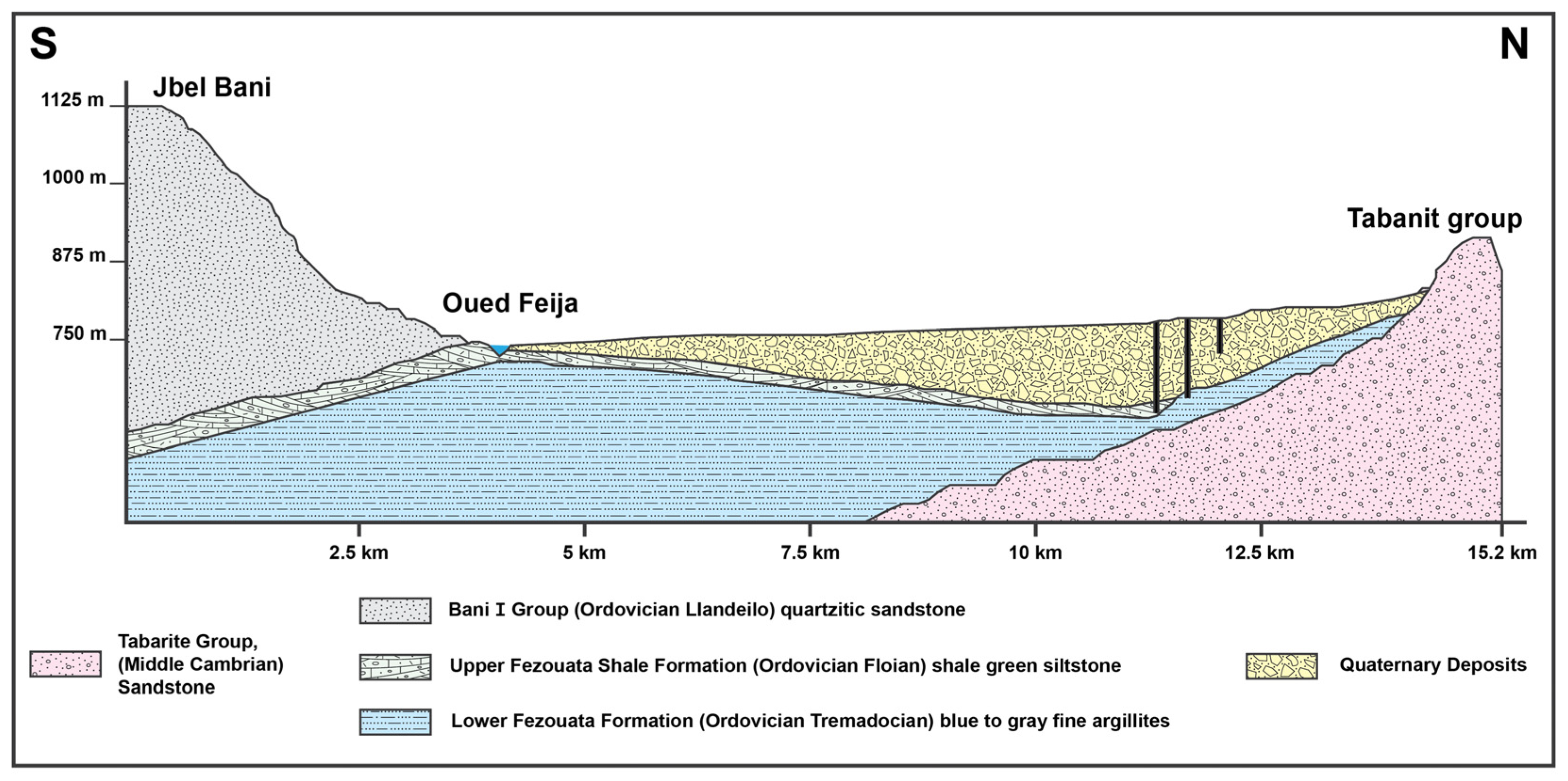

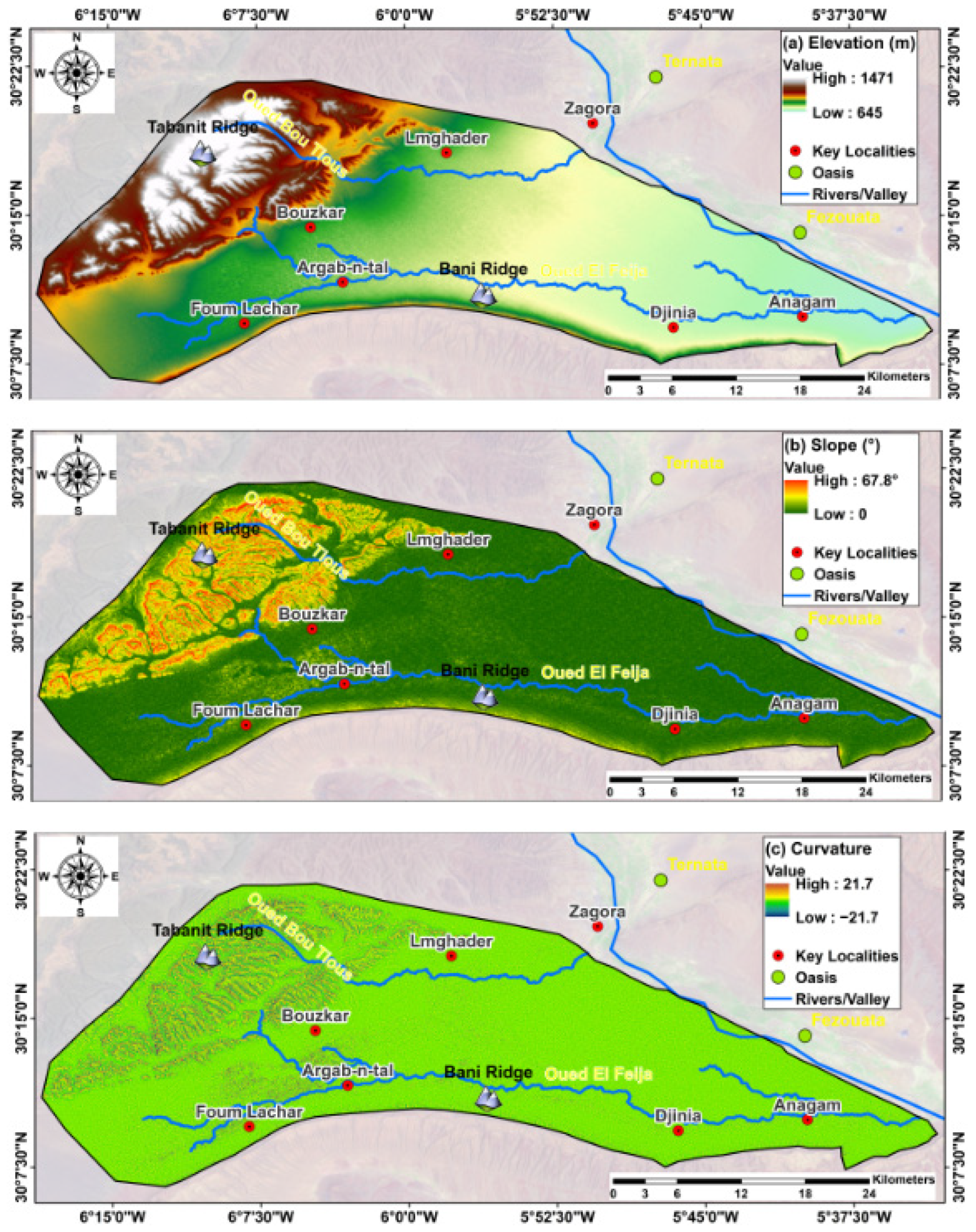

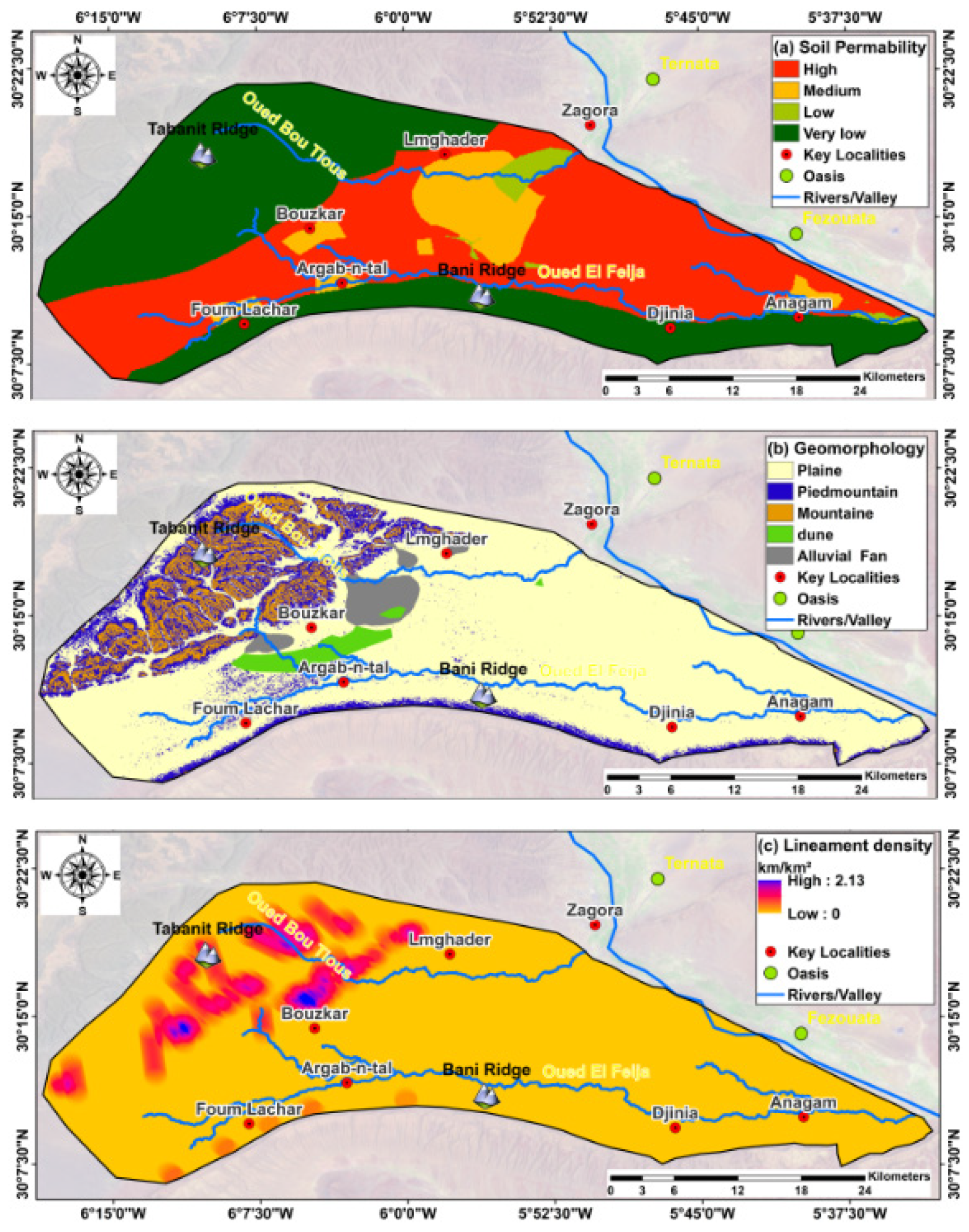
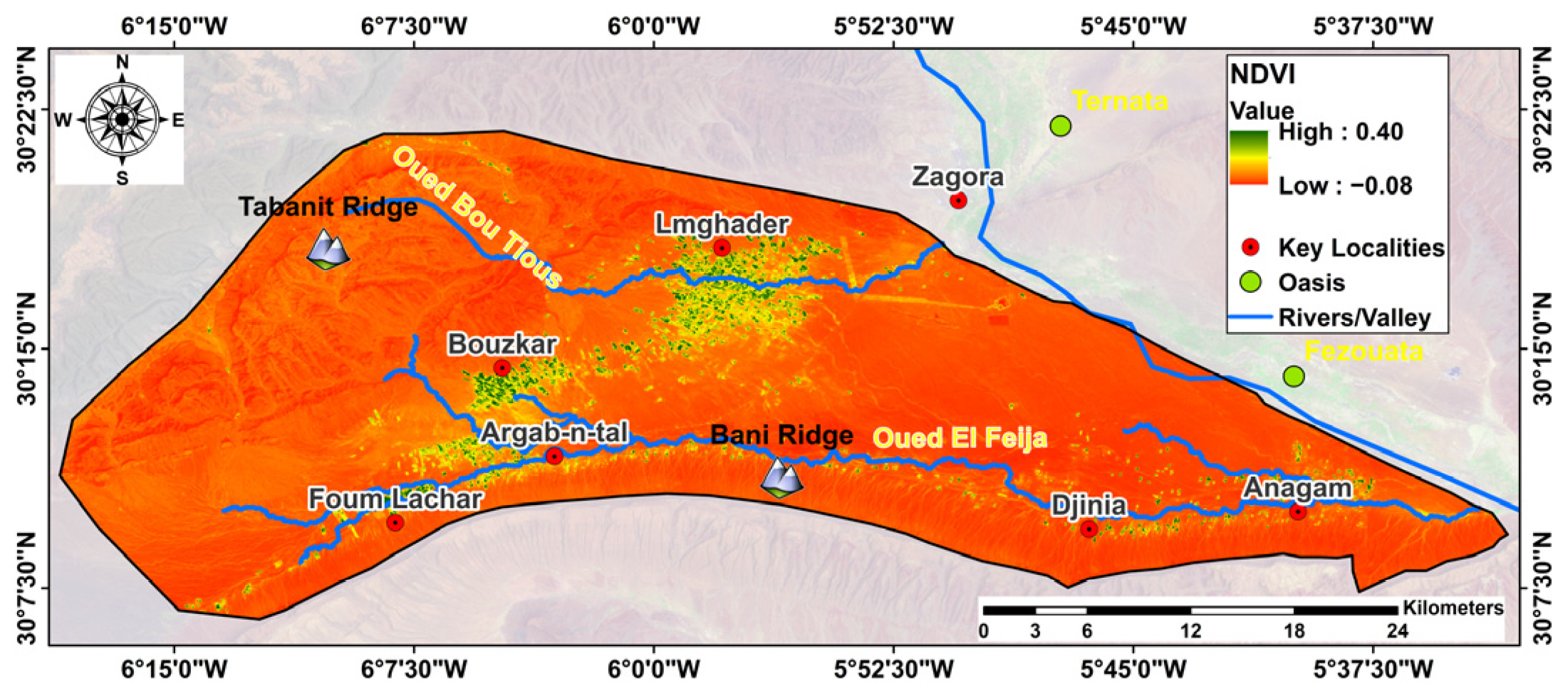

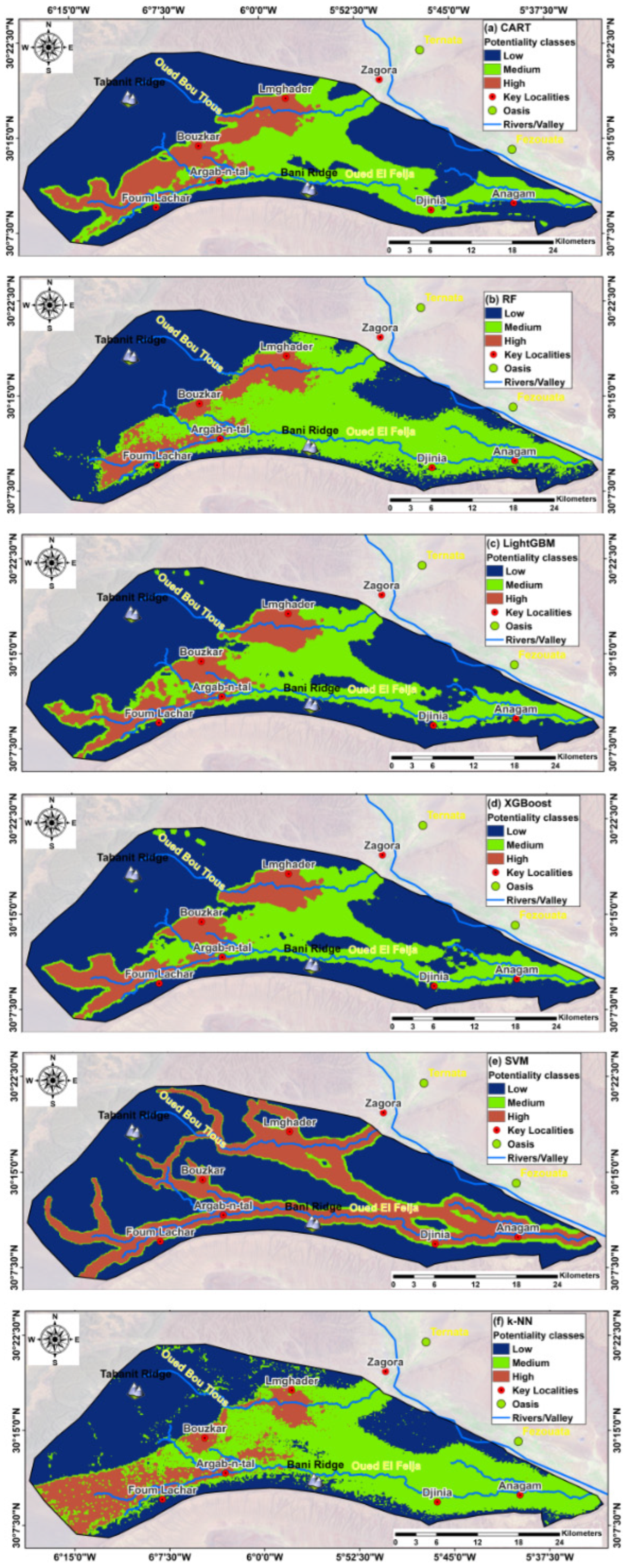
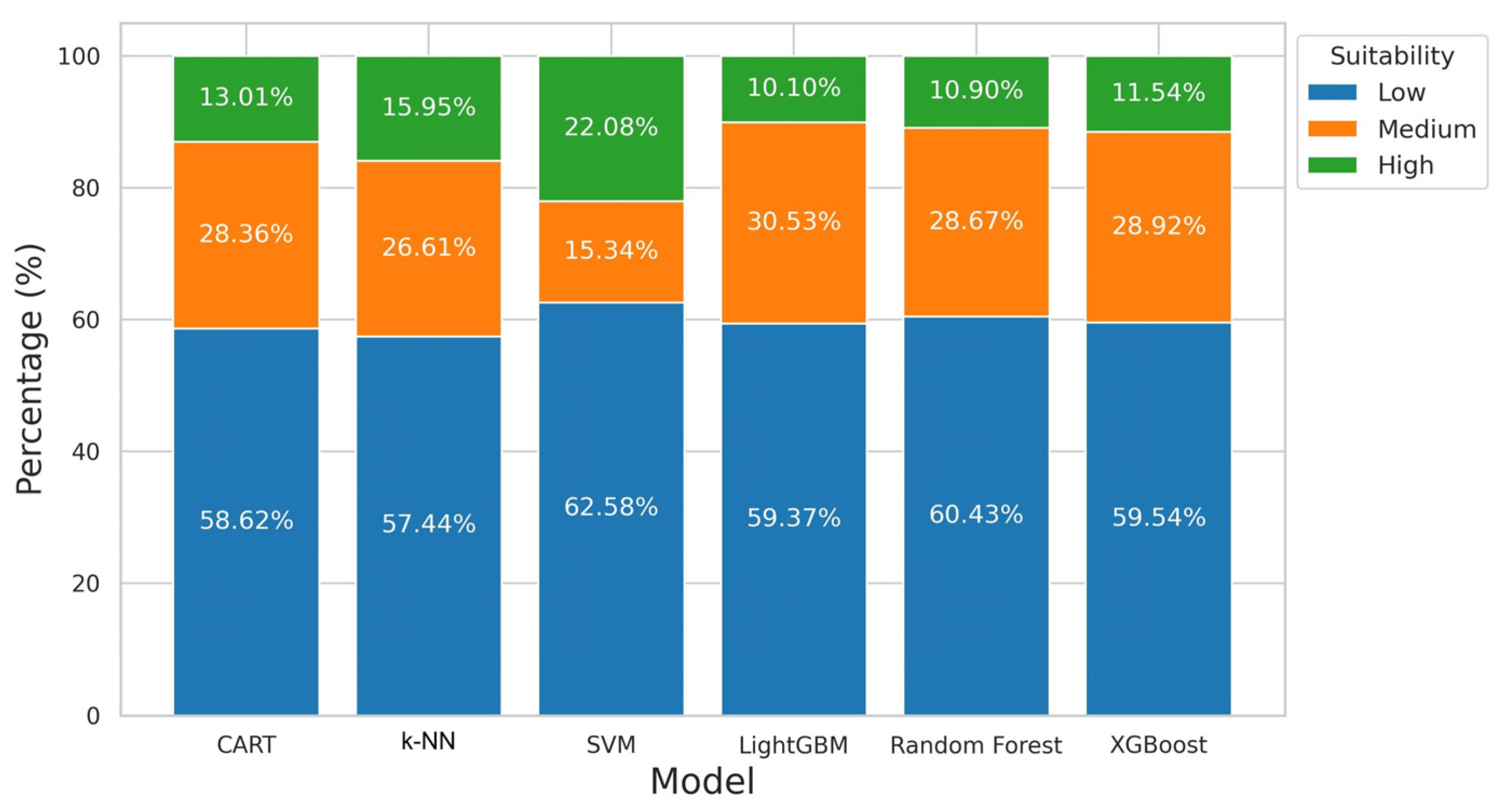
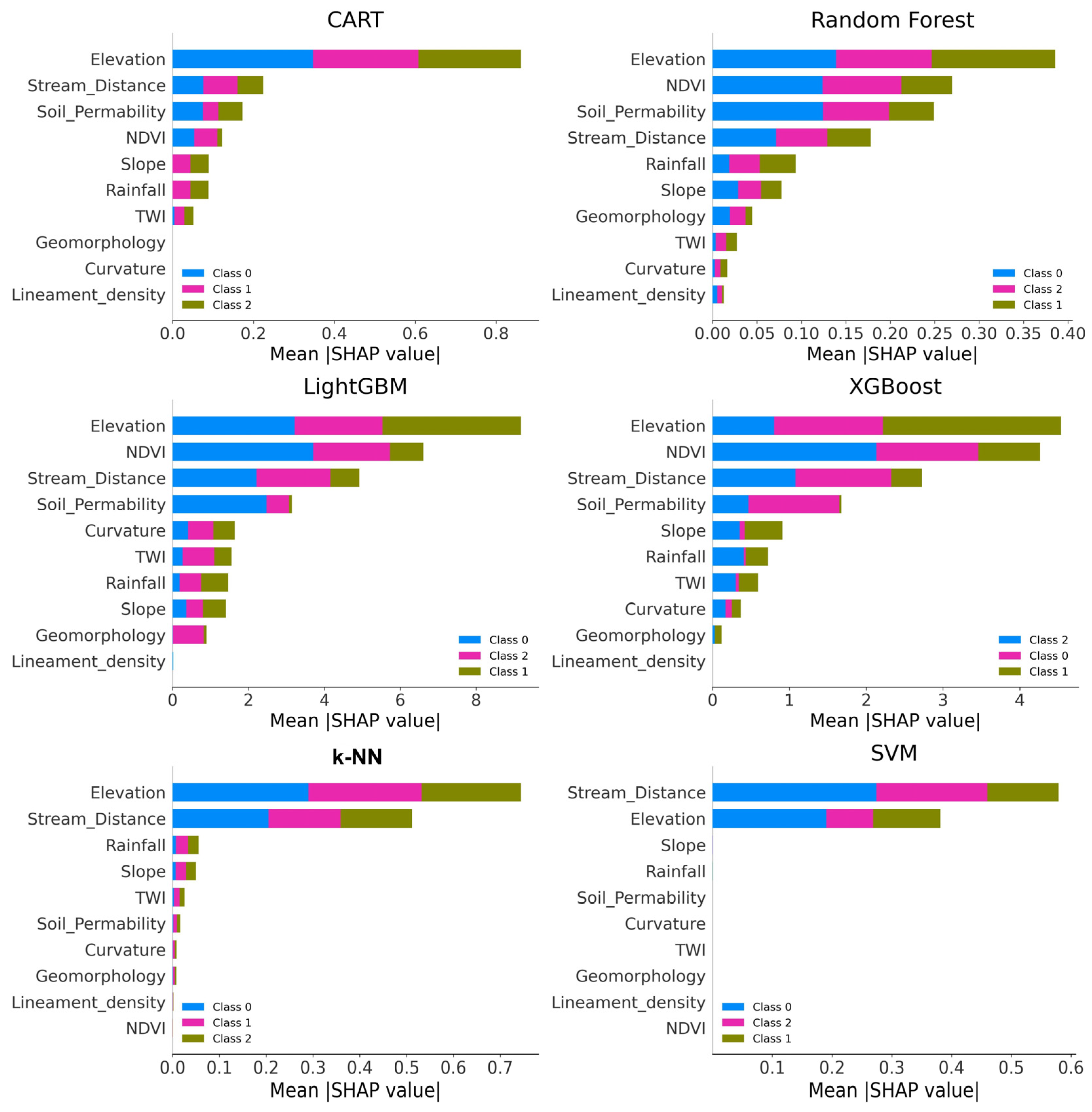
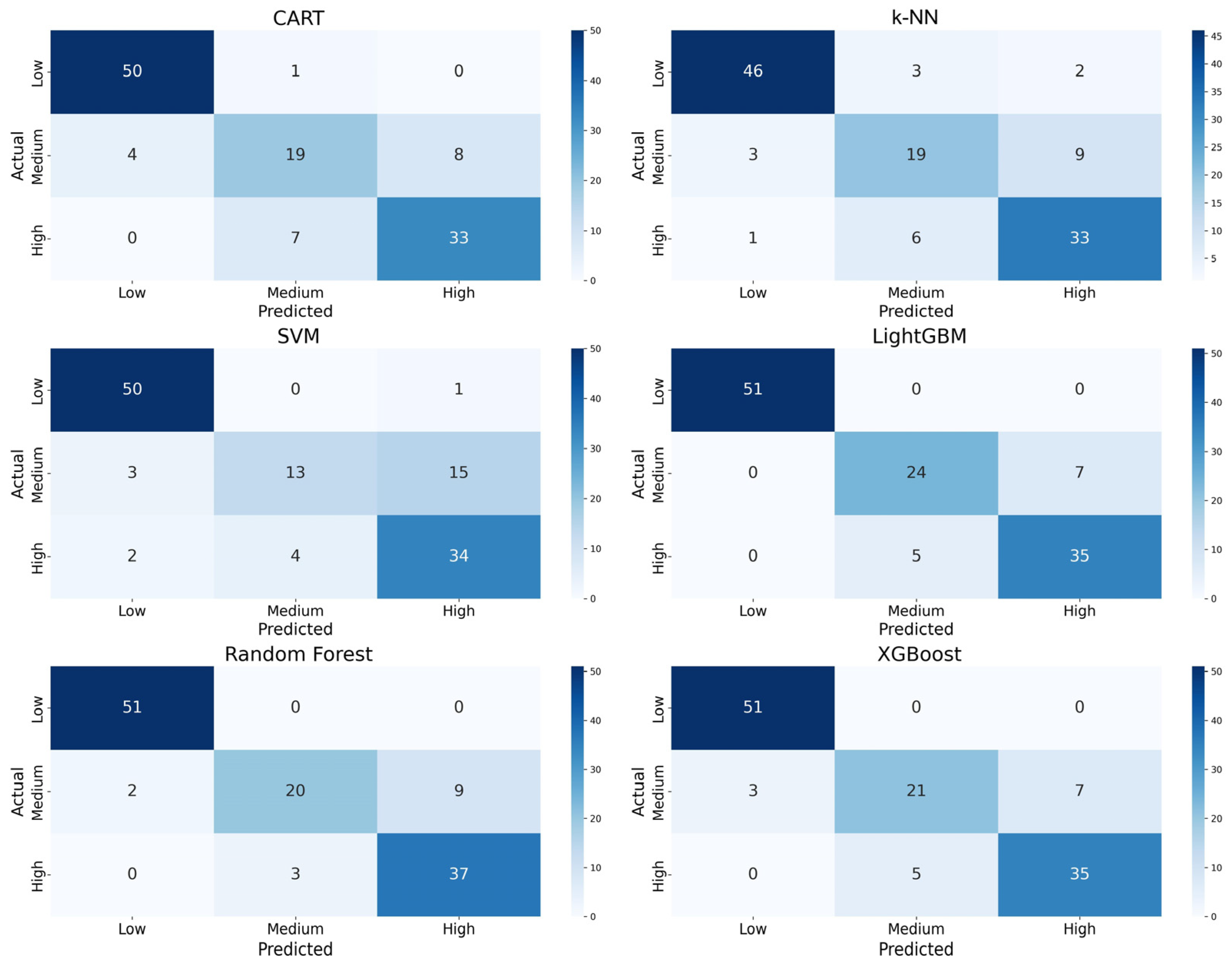
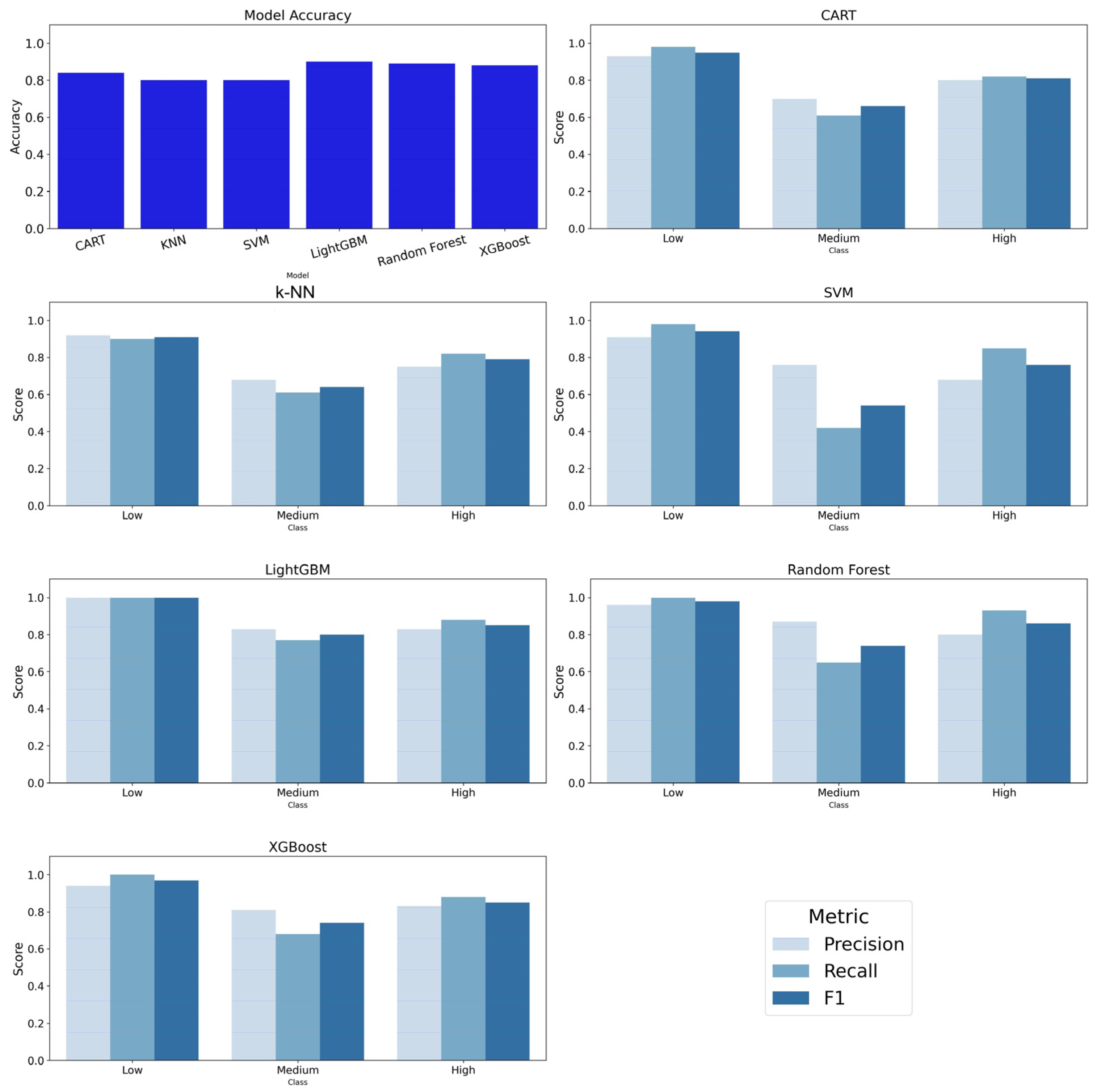

| Data | Scale | Source | Derived Layer by Authors |
|---|---|---|---|
| Soil sampling | 30 × 30 m | Soil permeability mapping was carried out based on field observations, soil sampling, and subsequent laboratory analyses of soil texture. | Soil permeability |
| Rainfall | 0.5° × 0.5° | NASA Prediction of Worldwide Energy Resources and the weather station in Zagora | Rainfall |
| Digital Elevation Model (DEM) | 30 × 30 m | USGS EarthExplorer https://earthexplorer.usgs.gov/ (accessed on 10 January 2025) | Slope, Lineament density, Curvature, TWI, Elevation, Distance from main streams |
| Satellite images | 30 × 30 m | Landsat 8 LC08_L1TP_200039_20230401_20230411_02_T1 from USGS EarthExplorer https://earthexplorer.usgs.gov/ (accessed on 10 January 2025) | NDVI |
| Topographic maps | 1:100,000 | Ministère de l’Agriculture et de la Réforme Agraire—Direction de la Conservation Foncière et des Travaux Topographiques. (1972). Carte du Maroc 1:100,000—Feuille NH-29-XVIII-2 (El Gloa’) [Carte topographique]. Division de la Carte, Rabat. | Topographic and geological maps, supplemented by field observations, were used as base layers for the development of original geomorphological and main stream distance layers by the authors. |
| 1:100,000 | Ministère de l’Agriculture et de la Mise en Valeur Agricole. (1968). Carte du Maroc 1:100,000—Feuille NH-30-XIII-1 (Zagora) [Carte topographique]. Direction de la Conservation Foncière, du Cadastre et de la Cartographie, Division de la Cartographie. Édition dressée, dessinée et publiée à Rabat. | ||
| Geological map | 1:200,000 | Ministère de l’Énergie et des Mines—Direction de la Géologie. (1989). Carte géologique du Maroc: Zagora—Coude du Dra—Hamada du Dra (p.p.) (Échelle 1:200,000) [Carte géologique]. Éditions du Service Géologique du Maroc, Notes et Mémoires n° 273. Maquette achevée en 1986. Cartographie et impression: Robertson Group, Royaume-Uni. |
| Layer | Methodology |
|---|---|
| Distances from main streams | To calculate distances from main streams in ArcGIS, the Euclidean Distance tool was used. This tool calculates the straight-line distance from each cell in the raster to the nearest stream. The main streams were digitized from the topographic map and are in a vector format (e.g., shapefile or feature class). The tool is located in: Spatial Analyst Tools > Distance > Euclidean Distance |
| TWI | TWI is calculated using Formula (1): TWI = ln( (1) where denotes the upslope contributing area for a given point, and α is the slope angle at that location. To derive the TWI values, data from a DEM is processed using standard hydrological tools—specifically, flow accumulation and slope analysis—to quantify both contributing area and gradient. |
| Soil Permeability Layer | Soil permeability classes were delineated utilizing laboratory data digitized within ArcMap 10.8, initially represented as polygons, and subsequently transformed into raster format. |
| NDVI | NDVI is calculated using Formula (2): NDVI (2) The resulting values range from −1 to +1, where higher values are associated with denser and healthier vegetation cover. In this study, the NDVI maps were derived using Band 5 (NIR) and Band 4 (Red) from multispectral satellite imagery. The calculation was performed in ArcGIS 10.8 using the Raster Calculator tool, accessible via: Spatial Analyst Tools > Map Algebra > Raster Calculator |
| Slope, Aspect, Elevation, and Curvature Layers | Slope, aspect, and elevation layers were derived in ArcGIS 10.8 through the analysis of a DEM. Slope was generated using the Slope tool, aspect was derived with the Aspect tool, determining the direction in which each cell faces based on the steepest downhill descent. Elevation data, representing the height above a specified datum, was obtained directly from the DEM. Additionally, curvature was computed using the curvature tool found in the Spatial Analyst Toolbox within ArcGIS software. This tool analyzes the change in slope at each cell to determine concave and convex areas of the terrain, providing insights into its shape and form. |
| Algorithm | General Definition | Application in Groundwater Recharge Studies |
|---|---|---|
| CART | The CART algorithm constructs a hierarchical tree structure by recursively partitioning the dataset into subsets according to the values of input features. This results in a tree-like algorithm that can be used for both classification and regression tasks [60]. | The CART algorithm is particularly useful for developing interpretable models, as it recursively splits the dataset based on key features, such as rainfall, soil permeability, and slope. This enables the effective classification and prediction of groundwater recharge potential zones [31,39]. |
| RF | RF is an ensemble-based learning algorithm that builds a collection of decision trees during the training process. For classification tasks, it outputs the most frequent class among the trees; while, for regression, it returns the average prediction of all individual trees [61]. | RF is widely employed in groundwater recharge mapping owing to its capacity to model complex, non-linear interactions among diverse features, such as land use, geological formations, and topographic variables. By aggregating the outputs of multiple decision trees, RF enhances predictive accuracy and model robustness [38,40,41]. |
| LightGBM | LightGBM is a gradient boosting framework optimized for speed and scalability. It incorporates techniques such as Gradient-Based One-Side Sampling and Exclusive Feature Bundling to efficiently manage large-scale datasets while maintaining high predictive performance [62]. | Particularly well-suited for large-scale groundwater recharge assessments due to its high computational efficiency and scalability. Its ability to manage high-dimensional datasets makes it effective for integrating diverse variables, such as rainfall, soil characteristics, and land cover, in predicting groundwater recharge potential [42,43,44]. |
| XGBoost | A scalable and efficient implementation of gradient boosting that uses parallel processing, tree pruning, and regularization to improve performance and avoid overfitting [63]. | A powerful tool for groundwater recharge mapping, as it can model complex, non-linear relationships between features like slope, geology, and land use, while avoiding overfitting [45]. |
| k-NN | k-NN algorithm is a non-parametric, instance-based method applicable to both classification and regression tasks. It operates by identifying the k most similar data points within the feature space and assigning a class label or value based on the majority vote (for classification) or the mean (for regression) of those neighbors [64]. | Used to classify or predict groundwater recharge potential by comparing the similarity of a location’s features (e.g., rainfall, soil type, slope) to the k-nearest labeled data points in the dataset [34,46]. |
| SVM | SVM is a supervised learning technique designed to identify the optimal hyperplane that best separates different classes in a high-dimensional feature space. It achieves this by maximizing the margin between the nearest data points from each class, known as support vectors [65]. | SVM is effective in capturing non-linear relationships among groundwater-related variables, such as topography and vegetation cover. It determines the optimal decision boundary that best separates zones of high and low groundwater recharge potential [37,47,48]. |
| Feature | CART (%) | RF (%) | LightGBM (%) | XGBoost (%) | k-NN (%) | SVM (%) |
|---|---|---|---|---|---|---|
| NDVI | 4.49 | 19.50 | 19.97 | 9.81 | 0 | 0 |
| Stream_Distance | 13.51 | 13.09 | 17.16 | 7.62 | 38.85 | 53.84 |
| Soil_Permeability | 42.86 | 15.87 | 4.02 | 53.55 | 0 | 0 |
| Rainfall | 5.57 | 10.62 | 13.60 | 2.43 | 1.61 | 0 |
| TWI | 2.81 | 3.55 | 10.02 | 2.06 | 0.04 | 0 |
| Geomorphology | 0 | 1.36 | 0.58 | 8.60 | 0 | 0 |
| Lineament_density | 0 | 1.75 | 0.05 | 0 | 0 | 0 |
| Curvature | 0.71 | 2.73 | 5.18 | 1.42 | 0 | 0 |
| Slope | 4.91 | 7.07 | 12.93 | 2.82 | 2.06 | 0 |
| Elevation | 25.15 | 24.47 | 16.49 | 11.68 | 57.43 | 46.16 |
| Metric | LightGBM | RF | XGBoost | CART | k-NN | SVM |
|---|---|---|---|---|---|---|
| Accuracy | 0.90 | 0.89 | 0.88 | 0.84 | 0.80 | 0.80 |
| Macro-Average AUC | 0.96 | 0.97 | 0.95 | 0.86 | 0.92 | 0.90 |
| Weighted-Average AUC | 0.97 | 0.97 | 0.96 | 0.88 | 0.93 | 0.91 |
| Macro F1-score | 0.88 | 0.86 | 0.85 | 0.81 | 0.78 | 0.75 |
| Weighted F1-score | 0.90 | 0.88 | 0.87 | 0.83 | 0.80 | 0.78 |
Disclaimer/Publisher’s Note: The statements, opinions and data contained in all publications are solely those of the individual author(s) and contributor(s) and not of MDPI and/or the editor(s). MDPI and/or the editor(s) disclaim responsibility for any injury to people or property resulting from any ideas, methods, instructions or products referred to in the content. |
© 2025 by the authors. Licensee MDPI, Basel, Switzerland. This article is an open access article distributed under the terms and conditions of the Creative Commons Attribution (CC BY) license (https://creativecommons.org/licenses/by/4.0/).
Share and Cite
Moumane, A.; Elmotawakkil, A.; Hasan, M.M.; Kranjčić, N.; Batchi, M.; Karkouri, J.A.; Đurin, B.; Gomaa, E.; El-Nagdy, K.A.; M. Youssef, Y. Integrating GIS, Remote Sensing, and Machine Learning to Optimize Sustainable Groundwater Recharge in Arid Mediterranean Landscapes: A Case Study from the Middle Draa Valley, Morocco. Water 2025, 17, 2336. https://doi.org/10.3390/w17152336
Moumane A, Elmotawakkil A, Hasan MM, Kranjčić N, Batchi M, Karkouri JA, Đurin B, Gomaa E, El-Nagdy KA, M. Youssef Y. Integrating GIS, Remote Sensing, and Machine Learning to Optimize Sustainable Groundwater Recharge in Arid Mediterranean Landscapes: A Case Study from the Middle Draa Valley, Morocco. Water. 2025; 17(15):2336. https://doi.org/10.3390/w17152336
Chicago/Turabian StyleMoumane, Adil, Abdessamad Elmotawakkil, Md. Mahmudul Hasan, Nikola Kranjčić, Mouhcine Batchi, Jamal Al Karkouri, Bojan Đurin, Ehab Gomaa, Khaled A. El-Nagdy, and Youssef M. Youssef. 2025. "Integrating GIS, Remote Sensing, and Machine Learning to Optimize Sustainable Groundwater Recharge in Arid Mediterranean Landscapes: A Case Study from the Middle Draa Valley, Morocco" Water 17, no. 15: 2336. https://doi.org/10.3390/w17152336
APA StyleMoumane, A., Elmotawakkil, A., Hasan, M. M., Kranjčić, N., Batchi, M., Karkouri, J. A., Đurin, B., Gomaa, E., El-Nagdy, K. A., & M. Youssef, Y. (2025). Integrating GIS, Remote Sensing, and Machine Learning to Optimize Sustainable Groundwater Recharge in Arid Mediterranean Landscapes: A Case Study from the Middle Draa Valley, Morocco. Water, 17(15), 2336. https://doi.org/10.3390/w17152336










